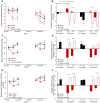Influence of body position and time of day on ocular rhythms
- PMID: 40695902
- PMCID: PMC12284202
- DOI: 10.1038/s41598-025-10873-7
Influence of body position and time of day on ocular rhythms
Abstract
To determine the influence of time of day and body position on axial length, microvasculature, and intraocular pressure (IOP), participants (N = 23, ages 22-46 years) were enrolled in four 4-hour experimental sessions, which varied by time of day (morning or night) and body position (upright or supine). Blood pressure, heart rate, IOP, biometry, and optical coherence tomography (OCT) and OCT angiography (OCTA) imaging were performed every 2 h. For supine sessions, IOP was also measured 10 min after position changed to upright. When upright for 4 h in the morning, axial length increased 10.0 ± 2.8 μm (P = 0.005). When supine in the morning, axial length decreased 8.7 ± 2.2 μm (P < 0.001). When upright at night, axial length decreased 18.3 ± 2.3 μm (P < 0.001), and choroidal thickness increased 7.7 ± 1.4 μm (P < 0.001). When supine at night, axial length decreased 37.0 ± 3.4 μm (P < 0.001) and choroidal thickness increased 14.1 ± 1.7 μm (P < 0.001). IOP measured 10 min after transitioning to an upright position showed an acute decrease (P < 0.05). No significant changes in retinal microvasculature were observed with body position or time (P > 0.05 for all). In conclusion, body position and time of day influence axial length, choroidal thickness, and IOP, indicating that extrinsic factors work in conjunction with diurnal factors to mediate ocular rhythms.
Keywords: Choroid; Circadian rhythm; Intraocular pressure; Posture.
© 2025. The Author(s).
Conflict of interest statement
Declarations. Competing interests: The authors declare no competing interests. Disclosures: AR: none; LO: Meta, LLC (financial support), Topcon (financial support), Zeiss (consulting).
Figures



Similar articles
-
Effects of tropicamide and compound tropicamide eye drops on ocular biological parameters and choroid thickness in children.BMC Ophthalmol. 2025 Jan 20;25(1):31. doi: 10.1186/s12886-025-03872-9. BMC Ophthalmol. 2025. PMID: 39833766 Free PMC article. Clinical Trial.
-
Ganglion Cell Layer Thickness as a Biomarker for Amyotrophic Lateral Sclerosis Functional Outcome: An OCT study.Rom J Ophthalmol. 2025 Apr-Jun;69(2):200-207. doi: 10.22336/rjo.2025.32. Rom J Ophthalmol. 2025. PMID: 40698100 Free PMC article.
-
Multifaceted behavioral interventions to improve topical glaucoma therapy adherence in adults.Cochrane Database Syst Rev. 2025 Jun 11;6(6):CD015788. doi: 10.1002/14651858.CD015788.pub2. Cochrane Database Syst Rev. 2025. PMID: 40497459 Review.
-
Twenty-four hour ocular and systemic diurnal rhythms in children.Ophthalmic Physiol Opt. 2019 Sep;39(5):358-369. doi: 10.1111/opo.12633. Epub 2019 Jul 22. Ophthalmic Physiol Opt. 2019. PMID: 31332822 Free PMC article.
-
Anti-vascular endothelial growth factor for neovascular glaucoma.Cochrane Database Syst Rev. 2023 Apr 3;4(4):CD007920. doi: 10.1002/14651858.CD007920.pub4. Cochrane Database Syst Rev. 2023. PMID: 37010901 Free PMC article.
References
-
- Holden, B. A. et al. Global prevalence of myopia and high myopia and Temporal trends from 2000 through 2050. Ophthalmology123, 1036–1042 (2016). - PubMed
-
- Jung, S. K., Lee, J. H., Kakizaki, H. & Jee, D. Prevalence of myopia and its association with body stature and educational level in 19-year-old male conscripts in seoul, South Korea. Invest. Ophthalmol. Vis. Sci.53, 5579–5583 (2012). - PubMed
-
- Flitcroft, D. I. The complex interactions of retinal, optical and environmental factors in myopia aetiology. Prog Retin Eye Res.31, 622–660 (2012). - PubMed
MeSH terms
Grants and funding
LinkOut - more resources
Full Text Sources
Medical

